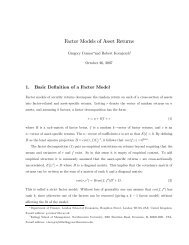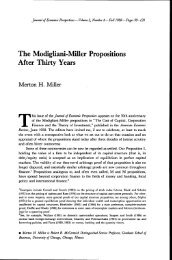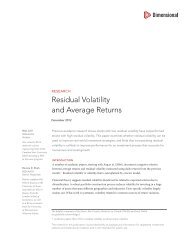Campbell, John Y, Jens Hilscher and Jan Szilagyi, 2005.
Campbell, John Y, Jens Hilscher and Jan Szilagyi, 2005.
Campbell, John Y, Jens Hilscher and Jan Szilagyi, 2005.
Create successful ePaper yourself
Turn your PDF publications into a flip-book with our unique Google optimized e-Paper software.
2 Data descriptionIn order to estimate a dynamic logit model we need an indicator of financial distress<strong>and</strong> a set of explanatory variables. The bankruptcy indicator we use is taken fromChava <strong>and</strong> Jarrow (2004); it includes all bankruptcy filings in the Wall Street JournalIndex, the SDC database, SEC filings <strong>and</strong> the CCH Capital Changes Reporter. Theindicator equals one in a month in which a firm filed for bankruptcy under Chapter7 or Chapter 11, <strong>and</strong> zero otherwise; in particular, the indicator is zero if the firmdisappears from the dataset for some reason other than bankruptcy such as acquisitionor delisting. The data span the months from <strong>Jan</strong>uary 1963 through December1998. We also consider a broader failure indicator, which equals one if a firm filesfor bankruptcy, delists, or receives a D rating, over the period <strong>Jan</strong>uary 1963 throughDecember 2003.Table 1 summarizes the properties of our bankruptcy <strong>and</strong> failure indicators. Thefirst column shows the number of active firmsforwhichwehavedataineachyear.The second column shows the number of bankruptcies, <strong>and</strong> the third column thecorresponding percentage of active firmsthatwentbankruptineachyear. Thefourth <strong>and</strong> fifth columns repeat this information for our failure series.It is immediately apparent that bankruptcies were extremely rare until the late1960’s. In fact, in the three years 1967—1969 there were no bankruptcies at allin our dataset. The bankruptcy rate increased in the early 1970’s, <strong>and</strong> then rosedramatically during the 1980’s to a peak of 1.5% in 1986. It remained high throughthe economic slowdown of the early 1990’s, but fell in the late 1990’s to levels onlyslightly above those that prevailed in the 1970’s.Some of these changes through time are probably the result of changes in thelaw governing corporate bankruptcy in the 1970’s, <strong>and</strong> related financial innovationssuch as the development of below-investment-grade public debt (junk bonds) in the1980’s <strong>and</strong> the advent of prepackaged bankruptcy filings in the early 1990’s (Tashjian,Lease, <strong>and</strong> McConnell 1996). Changes in corporate capital structure (Bernanke <strong>and</strong><strong>Campbell</strong> 1988) <strong>and</strong> the riskiness of corporate activities (<strong>Campbell</strong>, Lettau, Malkiel,<strong>and</strong> Xu 2001) are also likely to have played a role, <strong>and</strong> one purpose of our investigationis to quantify the time-series effects of these changes.The broader failure indicator tracks the bankruptcy indicator closely until theearly 1980’s, but towards the end of the sample it begins to diverge significantly. The5





